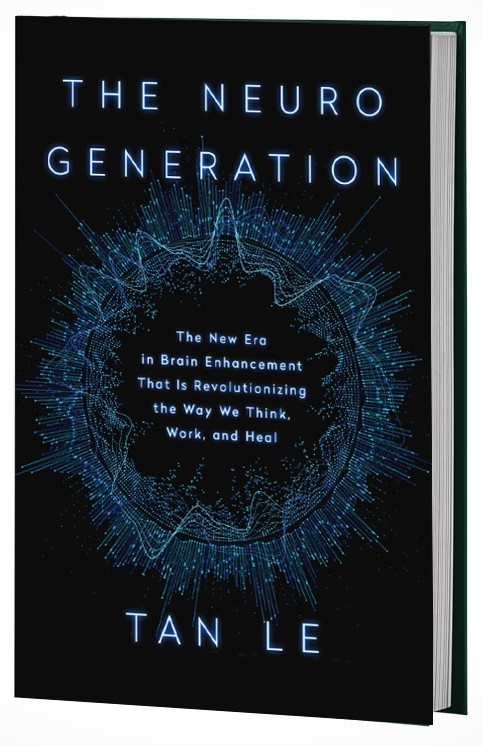The NeuroGeneration and Humankind’s Quest to Enhance the Brain
 Some people may be uneasy with the idea of “brain enhancement,” but the quest to boost our brainpower is nothing new; it is an essential part of human nature. Ever since Homo sapiens emerged nearly 200,000 years ago, we have been searching for ways to upgrade the hardware and wetware in our heads, and we’ve been creating and using tools to help us do it—physical and cognitive tools that help us solve problems and complete tasks more efficiently, tools that extend our natural abilities and allow us to do things that weren’t possible before. Language, numbers, science, education—these are all tools we’ve developed to improve our mental capacities.
Some people may be uneasy with the idea of “brain enhancement,” but the quest to boost our brainpower is nothing new; it is an essential part of human nature. Ever since Homo sapiens emerged nearly 200,000 years ago, we have been searching for ways to upgrade the hardware and wetware in our heads, and we’ve been creating and using tools to help us do it—physical and cognitive tools that help us solve problems and complete tasks more efficiently, tools that extend our natural abilities and allow us to do things that weren’t possible before. Language, numbers, science, education—these are all tools we’ve developed to improve our mental capacities.
Our most powerful tool for navigating the ever-changing world, however, is the brain itself. It took billions of years for modern humans to arrive on earth, and although we continue to evolve genetically, this process occurs at a painstakingly slow pace. Our brain is nature’s way of allowing us to adapt more quickly than we evolve. It’s the cognitive machinery that lets us create and cope with the modern world.
This most vital asset is also the seat of the self and the center of our personal universe. Everything we see, hear, and smell is a product of our brain, which filters the data gathered by our senses and converts it into the model of reality we experience. And yet we still know surprisingly little about the organ that is responsible for our human condition. Courtesy of recent advances in imaging tools, however, we’ve begun to unlock some of the secrets of the human brain. And of everything we have learned so far, the thing I find most amazing is that it is built to change. Our human brain is three pounds of pure potential.
For centuries, most doctors and scientists believed that the brain was a fixed entity. Longheld theories claimed that once you reached adulthood, the neurons, synapses, grey matter, and white matter in your skull could not be changed. Correction—it could change, but only in one way: for the worse. Injury could damage your brain, and recovery was thought to be impossible. Old age could lead to the death of neurons, which could never be replaced. If you had a mental health condition, you were stuck with it for the rest of your life.
Fortunately, the revolutionary science of neuroplasticity has debunked these notions. The medical and scientific communities now understand that the brain is in a constant state of change, a dynamic entity that has the ability to rewire, reprogram, and heal itself. The brain’s neurons, like trees in a rainforest, can sprout limbs that connect to other neurons in new ways to alter the neural networks inside our heads. Our brains change not only in response to the world around us, but are also constantly rewiring in response to how we use them. Activities that are frequently repeated are reinforced by the formation of additional neural pathways to support those activities. Neural pathways that are used often are strengthened, but if a neuron isn’t “fired and wired”—used within the network—it can become weakened or even die off. This means that far from our brains controlling us, we can control our brains. The transformative discovery that our thoughts, actions, and environment can impact how our brains are wired is what opened the door to the possibility of using emerging technologies to intentionally shape them.
Despite all that we have gleaned so far, several things limit what we know about the enigma between our ears:
Dead brains don’t talk. Much of what we have learned about the brain comes from dissecting those of deceased people. Jacopo Annese, an expert neuroanatomist at UCSD, has been dissecting and slicing brains since 1994. In 2009, about 400,000 people around the globe tuned in to watch Annese make 2,401 slices in the brain of famed amnesia patient “H.M.” Although the slices provided a new look at neuronal architecture, it was still dead tissue. It’s like looking at a flat map of a city. It depicts where the roads lead and where the buildings are located, but it doesn’t reveal what the people are doing inside those buildings, how they communicate and work with each other, or why they do what they do. That is the great mystery we are still trying to solve.
Pictures don’t tell the whole story. As humans, we are inherently attracted to images. About 30 percent of the brain’s neurons are dedicated to vision, compared to just 8 percent for touch and a mere 3 percent for hearing. This helps explain why, in our quest to understand the brain, we have looked to pictures to tell the story. Perhaps the first brain imaging tool, the microscope was invented in the 1590s, offering a way to view brain tissue at high magnification. Since then, brain imaging has come a long way with MRI, PET, CT, and SPECT, and modernday imaging tools such as functional MRI (fMRI) that attempt to map brain activity now provide clues as to where things happen and when they happen. Unfortunately, they don’t necessarily tell us why they happen. Without the “why,” we can’t decode the dynamics of the brain’s behavior. And with a system like the brain, which is constantly evolving, it’s the dynamics that hold the answers to many of the questions we have.
No two brains are alike. The folds of the human cerebral cortex are as individual as a fingerprint. This means that with 7.5 billion people on earth, there are 7.5 billion unique brains. The vast majority of brain research to date, however, has focused on educated males from the Western world. Females remain underrepresented in both human and animal trials. A 2017 review in eNeuro revealed that brain trials using only male animals outpaced female-only studies at a rate of 6.7 to one. Existing neuroscience research has also virtually ignored people in areas such as Africa, South America, and Asia.
As dramatic as the developments of the twentieth century were, what is to come in this century—even in just the next few decades—will be still more astounding. Our understanding of our limitations will be shattered as we explore the possibilities that arise when we bring minds, machines, and the material world together. While this integration will take many forms, what is most exciting to me is the way in which it allows us to expand the vast potential of the human brain. Thanks to more powerful tools, we are on the brink of unraveling the brain’s secrets—and using them to our advantage.
In the NeuroGeneration, we will have a much more intimate relationship with our neurons and synapses, understanding how they work and intentionally directing their activity to improve attention, creativity, productivity, and more. Enhancing and augmenting our brainpower in these ways will revolutionize the way we learn, the way we do business, and the way we heal disease.
 – This is an adapted excerpt from the new book The NeuroGeneration: The New Era in Brain Enhancement That Is Revolutionizing the Way We Think, Work, and Heal (BenBella Books, 2020) by neurotech pioneer Tan Le. An inventor, explorer, and entrepreneur, Tan is the founder and CEO of EMOTIV, a San Francisco-headquartered neuroinformatics company on a mission to improve understanding of the human brain and to develop a platform for research and innovation.
– This is an adapted excerpt from the new book The NeuroGeneration: The New Era in Brain Enhancement That Is Revolutionizing the Way We Think, Work, and Heal (BenBella Books, 2020) by neurotech pioneer Tan Le. An inventor, explorer, and entrepreneur, Tan is the founder and CEO of EMOTIV, a San Francisco-headquartered neuroinformatics company on a mission to improve understanding of the human brain and to develop a platform for research and innovation.


